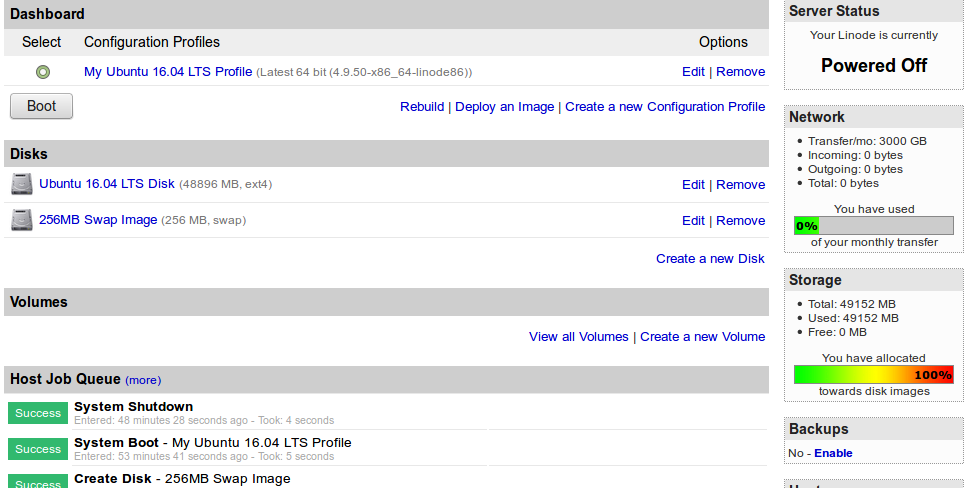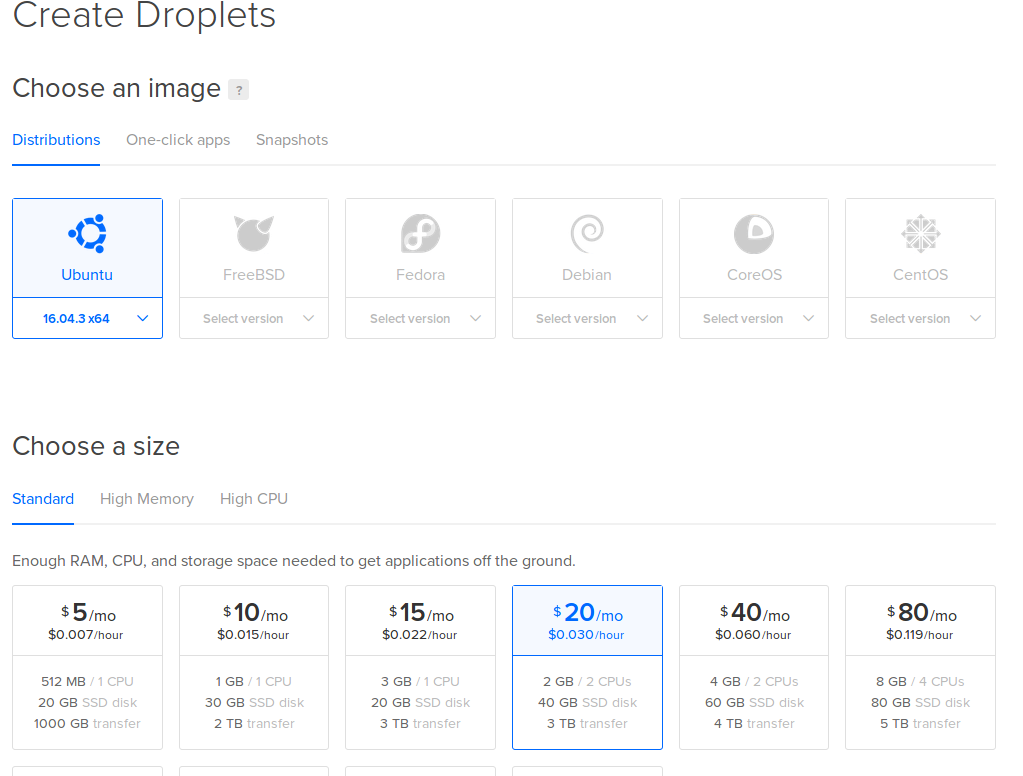DigitalOcean vs Linode 2023
New article published on the topic:
Comparison: Linode vs DigitalOcean - best VPS in 2023
Update mid 2020: DigitalOcean Vs. Linode - Equilibrium
In 2020 both VPS providers offer good level of service, features and price plans. I am impressed with evolution of the service for both companies. As a long year VPS user for me it's important to have:
- reliable
- cheap
- easy to maintain
- feature set
The user interface (personally for me) it's slightly better for DigitalOcean. DigitalOcean provides more 1-Click Applications which you can deploy on VMs - for example Ghost blog. Linode on the other hand offers better region coverage for Asia Pacific - including - Sydney and Tokyo(they are available only for some plans!).
Let's discuss about price:
- Lowest plans
- Linode - Nanode 1GB - 5$ / 1 CPU / 1 GB RAM / 25 GB
- DigitalOcean - Standard 5$ - 5$ / 1 CPU / 1 GB RAM / 25 GB
- Medim range
- Linode - Linode 4GB - 20$ / 2 CPU / 4 GB RAM / 80 GB
- DigitalOcean - Standard 20$ - 20$ / 2 CPU / 4 GB RAM / 80 GB
- CPU optimized
- Linode - Linode 4GB - 30$ / 2 CPU / 4 GB RAM / 80 GB
- DigitalOcean - CPU Optimized 40$ - 40$ / 2 CPU / 4 GB RAM / 25 GB
- High Memory
- Linode - Linode 24GB - 60$ / 1 CPU / 24 GB RAM / 20 GB
- DigitalOcean - Memory Optimized 90$ - 90$ / 2 CPU / 16 GB RAM / 50 GB
- GPU(Plans are offer by Linode only)
- Dedicated 32GB + RTX6000 GPU x1 - $1000
Both companies provides offer wide price range and plans. You need to pay attention on small and important details like:
Note: Whichever VPS provider you choose, it’s important to do your homework and make careful comparisons. My advice is to test both VPS and decide which one suits your needs better - you can start with the cheapest plan $5. By clicking on the links bellow you may get extra bonus(from 20$ to 60$).
Comparing popular VPS Providers in 2018
My goal was to see how Linode VPS matches up with DigitalOcean in 2018. I've used the both services for last 5 years and in many cases they offered good, reliable and modern service
The review is targeting bloggers and small business website owners like me(from cost savings point of view and security). For VPS I prefer to not use: Google Cloud, Amazon AWS, and Microsoft Azure. I'm using the last ones if I need a server for deep learning( Artificial intelligence as Google Cloud is my favorite in this group).
When to chose DigitalOcean
If you want one click app with low to medium price you can chose: DigitalOcean
When to chose Linode
When you’re looking for a cheap plan: High Memory, CPU dedicated or GPU you can chose: Linode
Update 2020: Digital ocean offer better service
The service offered by DigitalOcean is better:
- offers more options
- pricing plans
- applications
- frameworks
- good support
- great knowledge base and community where you can find help
Also DigitalOcean offers great benefits for new clients like:
Get started on DigitalOcean with a $100, 60-day credit for new users.
So you will get 5 months of pretty good VPS service for free if you decide to test it. You can use this link to register: DigitalOcean $100, 60-day credit.
Big companies who use DigitalOcean in 2020:
- Docker
- GitLab
- Slack
- WeWork
You can sign up in DigitalOcean with Google or Github.
Many applications and frameworks can be used with one click with DigitalOcean:
- Ghost Blog platform
- WordPress
- NodeJS
- Django
- MySQL
- MongoDB
- Grafana
- Prometheus
and much more.
One really great benefit for me is that downtime for their services for last 7 years is under 1%.
Update 2019: Digital ocean is better
Using digital ocean and linode for full 2018 I can share that DigitalOcean offers much better service, user experience and plans in comparison to Linode. The tax advantage of Linode is not available anymore. My reasons to choose only DigitalOcean as my VPS provider in 2019 are listed below:
- The both companies offer similar plans and provide reliable services. A would give slight advantage to DigitalOcean.
- both have plans from 5 $ per month up to 1000$ with small differences
- There's a beta support for Linode for Paypal which is a good direction for the company.
- The lack of wide framework support and the bad user interface make my choice for 2019.
- Another advantage of DigitalOcean is: Kubernetes are provided as master server components for free.
- Pricing
Linode
| Linode 4GB | |
|---|---|
| 4 | GB RAM |
| 2 | CPU Cores |
| 80 | GB SSD Storage |
| 4 TB | Transfer |
| Tax | yes |
| $20/mo | $0.030/hr |
| Linode 8GB | |
|---|---|
| 8 | GB RAM |
| 4 | vCPUs |
| 160 | GB SSD Storage |
| 5 TB | Transfer |
| Tax | yes |
| $40/mo | $0.030/hr |
DigitalOcean
| DigitalOcean 4GB | |
|---|---|
| 4 | GB RAM |
| 2 | CPU Cores |
| 80 | GB SSD Storage |
| 4 TB | Transfer |
| Tax | yes |
| $20/mo | $0.030/hr |
| DigitalOcean 8GB | |
|---|---|
| 8 | GB RAM |
| 4 | vCPUs |
| 160 | GB SSD Storage |
| 5 TB | Transfer |
| Tax | yes |
| $40/mo | $0.030/hr |
Update February:
there are some changes in the prices for Digital ocean. Information below is updated. Here is quick comparison between most popular plans of both companies:
| Linode 4GB | |
|---|---|
| 4 | GB RAM |
| 2 | CPU Cores |
| 48 | GB SSD Storage |
| 3 TB | Transfer |
| Tax | no |
| $20/mo | $0.030/hr |
| Linode 4GB | |
|---|---|
| 4 | GB RAM |
| 2 | vCPUs |
| 80 | GB SSD Storage |
| 4 TB | Transfer |
| Tax | yes |
| $20/mo | $0.030/hr |
So as of February 2018 the popular plans seems to be similar. The only big difference could be considered to be the taxation which is reviewed in next section.
Taxes
One difference that may impact you is about taxes. Linode seems to not charge taxes. Digital Ocean seems to calculate taxes for some regions like: Tax Help:
- Australia
- Tax Help - EU
- Tax Help - Canada
- Tax Help - India
So you can check are you in the list and should you consider paying taxes on the amount.
So for example for non-business European Union customers you will need to pay 20 percent more (depending on the country) to the final price.
Benefits of Linode and DigitalOcean
I know from my experience that DigitalOcean and Linode service in comparison to big brand cloud resources is at least 3 times cheaper for the small VMs with a basic configuration.
Linode
Linode is best known with its customer service and support quality. With great support and good performance they become one of the leaders for small and middle site business. The interface is old school and it could be considered as a cons but on the other hand is easy to use and simple.
In 2018 Linode provides best price over the concurrents with their plans. My favorite plans are:
Linode Nanode
$5/mo
($.0075/hr)
1 GB RAM
1 CPU Core
25 GB SSD Storage
1 TB Transfer
40 Gbps Network In
Linode 2GB
$10/mo
($.015/hr)
2 GB RAM
1 CPU Core
50 GB SSD Storage
2 TB Transfer
40 Gbps Network In
Linode 4GB
$20/mo
($.03/hr)
4 GB RAM
2 CPU Cores
80 GB SSD Storage
4 TB Transfer
40 Gbps Network In
The offer is twice in comparison with other (and with DigitalOcen ) VPS providers.
Creating a new Linode and setting it up is fairly easy task which consist of:
Short Linode tutorial
- Sign up for Linode
- provide billing details is required
- create linode
- select hosts: US East, US South, US Central, US West, Frankfurt, London, Singapore, Tokyo 2
- select plan 4GB 2 CPU : Linode Pricing. p.S. have in mind that Linode is not working with Paypal.
- Build an image
- Go to dashboard
- Select your preferred OS:
- Ubuntu 16.04, 17.10, Debian 9, CentOS, Fedora
- select swap and RAM
- select root password
- Boot
- small button under the linode
- Remote access
- Go to tab Remote access
- or ssh [email protected] - the IP of your server**** - you will be asked for the root password that you setup earlier

Try Linode with 10$ credit
Order Linode - Use code LINODE10
10$ is enough for two months to test the basic plan of Linode. The basic setup could take about 1 hour.
For more information:
Linode Documentation and Tutorials
DigitalOcean
As a experience user of several providers for virtual private server I know why DigitalOcean are so useful for web developers and system administrators. They offer extraordinary service with many new features like:
- Block Storage
- SSD
- two factor authentication
- many applications like OScommerce, Wiki server, mail etc
The service is reliable and for few years I've experience a few downtowns. User interface is good looking and easy to use. You can monitor the traffic and usage of your servers.
As Linode they also have rich documentation and tutorial base. A strong community which is helping each other.
The plans are a bit more expensive in comparison to Linode but it's worth it because of the quality and the extra features.
My favourite plans are(in 2019 you have 3 plans for 15$):
DigitalOcean $15/mo
Flexible Droplets
($.015/hr)
3 GB RAM
1 CPU Core
60 GB SSD Storage
3 TB Transfer
DigitalOcean $15/mo
Flexible Droplets
($.015/hr)
2 GB RAM
2 CPU Core
60 GB SSD Storage
3 TB Transfer
DigitalOcean $15/mo
Flexible Droplets
($.015/hr)
1 GB RAM
3 CPU Core
60 GB SSD Storage
3 TB Transfer
DigitalOcean $20/mo
Standart Droplets
($.03/hr)
4 GB RAM
2 CPU Cores
80 GB SSD Storage
4 TB Transfer
Short DigitalOcean startup tutorial
- Sign up for DigitalOcean
- provide billing details is required
- create droplet ( the Linode equivalent is Linode - it's a server unit which can be deployed with an image).
- Create - big green button on the top right
- choose image: Ubuntu 16.04, 17.10, Debian 9, CentOS, Fedora 26
- or choose One-click apps: django, LAMP, Ghost, WordPress, Machine Learning and AI etc.
- choose a size (or plan) - Digital Pricing.
- select hosts: New York 1,2 or 3( the difference is the location in the city), San Francisco, Amsterdam, Singapore, London, Frankfurt, Toronto, Bangalore
- Customize
- SSH keys, IPv6, Monitoring, Backups
- Create
- Go to menu droplets
- Add a domain
- Access console
- Resize droplet
- View usage
- Enable backups
- Edit tags
- Destroy
- Boot - it's auto started
- Remote access
- Go to tab Remote access
- or ssh [email protected] - the IP of your server

Try DigitalOcean: Get $10 in credit
10$ is enough for two months to test the basic plan of DigitalOcean. The basic setup could take about 1 hour.









